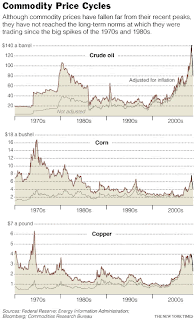Many negative feedback loops are getting activated. There is a deep-seated fear that the financial rescue will add to an already-swelling federal budget deficit and force the Treasury to borrow heavily in the capital markets, thereby "crowding out" private investment besides forcing up interest rates and Treasury yields. Further, the recessionary expectations and weaker profits will discourage investment decisions and make companies postpone new hirings, thereby bringing down economic growth and forcing up unemployment.
The "negative wealth effect" due to declining values of real estate and shares coupled with the credit squeeze, will keep consumer spending, which has been the engine of recent economic growth at over 60% of the US GDP, very weak. The fall in retail sales is a confirmation of this trend. With Europe too experiencing similar economic environment, prospects for one of the larger remaining engines of economic growth, exports, too look very bleak.
With credit scarce, private firms are not the only ones getting squeezed. Cities, states and other local government agencies are facing problems in accessing the debt markets as the Municipal Bond market is almost frozen. Yields on municipal bonds jumped to 6.74%, up from 5.44% a month earlier.
Adding to these woes, David Leonhardt feels that income for the median household will be lower in 2010 than it was a full decade earlier. Falling pay will weigh on living standards, consumer spending and economic growth.
In keeping with the anemic global economic environment, demand has been declining, thereby driving commodity prices down. From late 2001 until mid-2008, the price of oil rose 800%, copper rose 700% and wheat rose 400%, whereas the decline of recent weeks has taken virtually every major commodity more than halfway back to its late 2001 price, adjusted for inflation. Wheat prices are down to $6 a bushel from $13 in March 2008, soya bean has fallen to $9 a bushel from $16 in July, and since the spring and early summer, oil has dropped 44%, while metals like aluminum, copper and nickel have declined by a third or more.

In many ways, the falling commodity prices may be the one silver lining in the dark clouds gathering on the horizon. It is likely to ease inflationary fears and help Central Banks keep interest rates low, besides increasing the real incomes of consumers. But the decreases may not be much if the Chinese and other emerging economies continue to grow even at a slightly reduced pace.
Update 1
Anil Kashyap and Doug Diamond in an FAQ about the financial crisis here.
No comments:
Post a Comment